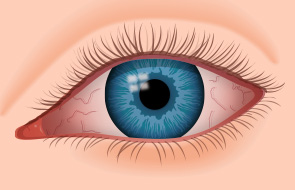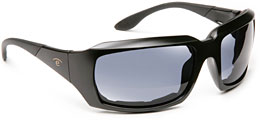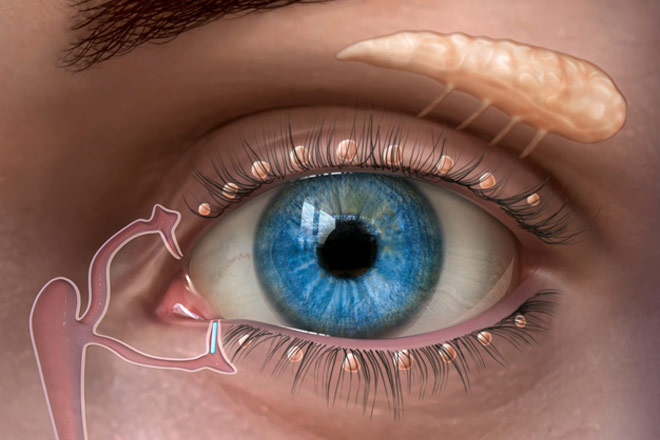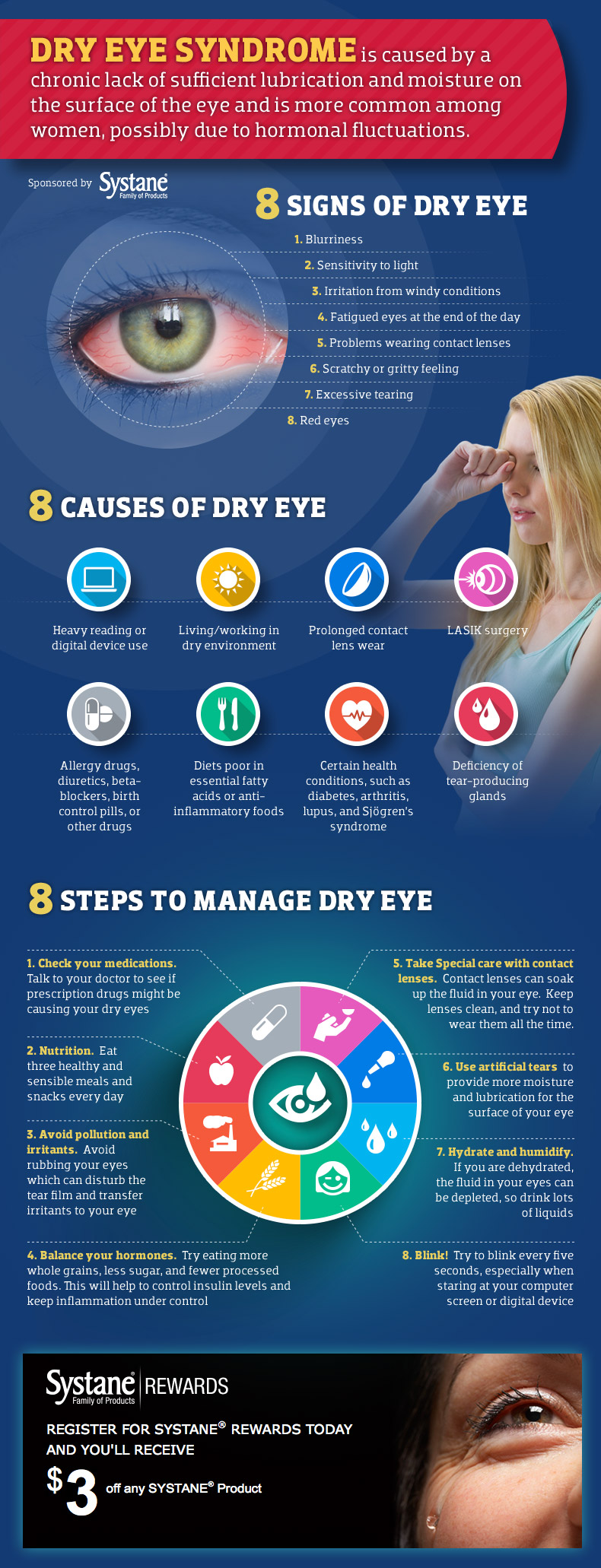Dry Eye Syndrome
Dry Eye Syndrome
Dry eye syndrome is caused by a chronic lack of sufficient lubrication and moisture on the surface of the eye.Its consequences range from subtle but constant irritation to inflammation of the anterior (front) tissues of the eye.Dry eyes also are described by the medical term, keratitis sicca, which generally means decreased quality or quantity of tears. Keratoconjunctivitis sicca refers to eye dryness affecting both the cornea and the conjuctiva.
Dry Eye Symptoms
Persistent dryness, scratchiness, red eyes and a burning sensation are common symptoms of dry eyes. These symptoms alone may prompt your eye doctor to diagnose dry eye syndrome.

Dry eyes can become red and irritated, causing a feeling of scratchiness.
But sometimes your eye doctor may want to measure the amount of tears in your eyes. A thin strip of filter paper placed under the lower eyelid, called a Schirmer test, is one way to measure tear production.Another symptom of dry eyes is a "foreign body sensation," which is a feeling that something is in your eye.And it may seem odd, but dry eye syndrome also can cause watery eyes. This is because dryness on the eye's surface sometimes will overstimulate production of the watery component of your tears as a protective mechanism.
What Causes Dry Eyes?
Tears bathe the eye, washing out dust and debris and keeping the eye moist. They also contain enzymes that neutralize microorganisms that colonize the eye. Tears are essential for good eye health.
Tears are complex, containing many different essential elements, including oils produced by special glands in the eyelids called meibomian glands. These oils prevent evaporation of the tears.In dry eye syndrome, the lacrimal gland or associated glands near the eye don't produce enough tears, or dysfunction of the meibomian glands reduces oil output, leading to excessive evaporation of the tears.
This is called evaporative dry eye and is now considered to be the primary cause or a contributing factor of most cases of dry eye.Dry eye syndrome has many causes. It occurs as a part of the natural aging process (especially during menopause in women); as a side effect of many medications, such as antihistamines, antidepressants, certain blood pressure medicines, Parkinson's medications and birth control pills; or because you live in a dry, dusty or windy climate.
If your home or office has air conditioning or a dry heating system, that too can dry out your eyes. Another cause is insufficient blinking, such as when you're staring at a computer screen all day.Dry eyes also are a symptom of systemic diseases such as lupus, rheumatoid arthritis, ocular rosaceaor Sjogren's syndrome (a triad of dry eyes, dry mouth and rheumatoid arthritis or lupus).Long-term contact lens wear is another cause; in fact, dry eyes are the most common complaint among contact lens wearers.
Recent research indicates that contact lens wear and dry eyes can be a vicious cycle. Dry eye syndrome makes contact lenses feel uncomfortable, and evaporation of moisture from contact lenses worsens dry eye symptoms. Newer contact lens materials and lens care products can help reduce contact lens dryness.Incomplete closure of the eyelids, eyelid disease and a deficiency of the tear-producing glands are other causes.
Tears consist of three essential components:
- The outer, oily lipid component
- The middle, watery, lacrimal component
- The innermost component, consisting of mucous or mucin
Each component of the tear film serves a critical purpose. For example, tear lipids prevent evaporation and increase lubrication, while mucins help anchor the tears to the ocular surface.
Each tear component is produced by a different gland:
- The outer oily component is produced by meibomian glands in the eyelids.
- The watery component is produced by lacrimal glands located above the outer corner of the eyes.
- The inner mucoid component is produced by goblet cells in the conjunctiva.
A problem with any of those sources can result in tear instability and dry eyes.Dry eye syndrome is more common among women, possibly due to hormonal fluctuations. A recent study also indicates that the risk of dry eyes among men increases with age.Recent research suggests that smoking, too, can increase your risk of dry eyes.With increased popularity of cosmetic eyelid surgery (blepharoplasty) for improved appearance, dry eye complaints now occasionally are associated with incomplete closure of eyelids following such a procedure.
Dry Eye Disease High Among Office Computer Users
More than 75 percent of women who routinely use a computer at work may suffer from dry eye disease (DED), says a study.Researchers in Japan investigated the tear function and prevalence of dry eye symptoms among office workers who routinely use a computer on the job. Findings for 561 office workers (average age 43.3 years) were included in the study results. Participants completed questionnaires and underwent dry eye testing.The percentage of female computer users with "definite or probable" DED was 76.5 percent; among male workers, it was 60.2 percent. Risk factors for dry eye included being over 30 and using a computer more than eight hours per day.The study authors concluded dry eye disease is prevalent among young to middle-aged Japanese VDT users and that measures to reduce the adverse effects of computer use on the eye's surface may improve public health and quality of life for office workers.

Reading More Slowly? Maybe It's Your Dry Eyes
Discomfort and redness aren't the only symptoms of dry eyes. Reading speed can slow down, too.This is according to a study that measured reading speed and contrast sensitivity among 52 adult dry eye sufferers and a 20-member control group. The study showed that contrast sensitivity was not significantly different across the groups, but reading speed was. And reading rates decreased as the severity of the dry eye disease increased.Researchers concluded that reading speed could be a measure of treatment benefit for dry eye sufferers.

How Common Are Dry Eyes?
Dry eyes and dry eye symptoms are very common, particularly among older adults. And a consumer survey commissioned by Allergan suggests dry eyes are even more prevalent than previously believed.
The survey found:
- 48 percent of adult Americans regularly experience dry eye symptoms.
- 42 percent of women age 45 to 54 who have dry eye symptoms report blurred vision associated with the condition.
- Women more frequently than men report having difficulty using a computer due to dry eye symptoms (62 vs. 44 percent).
- 43 percent of adults with dry eye symptoms say they experience difficulty reading due to their symptoms.
- Among adults age 55 and older, 30 percent of men and 19 percent of women say they have experienced dry eye symptoms for more than 10 years.
- 19 percent of adults say they use over-the-counter eye drops at least five times per week to treat dry eye symptoms.
- 63 percent of adults who use non-prescription eye drops to treat dry eyes say the drops are not effective or only somewhat effective in managing their symptoms.
The survey also found that though dry eyes cause problems for nearly half of adult Americans, many people fail to seek professional help for dry eye symptoms: 69 percent of respondents who experienced symptoms said they had not visited an eye care professional for dry eye treatment.
Treatment for Dry Eyes
Dry eye syndrome is a chronic and typically progressive condition that may not be completely curable (depending on the cause). But the accompanying dryness, scratchiness and burning can be managed. Because dry eyes can be caused by many different things, a variety of treatment approaches are used.
Eye drops and other lubricants. Your eye care practitioner may prescribe artificial tears, which are lubricating eye drops that may alleviate the dry, scratchy feeling. Some artificial tears address specific tear deficiencies, such as lack of sufficient lipids.
Prescription eye drops called Restasis (Allergan) go one step further: they help your body produce more tears by reducing inflammation associated with dry eye syndrome.
Another option for dry eye treatment is called Lacrisert, a tiny insert filled with a lubricating ingredient (hydroxypropyl cellulose). The insert is placed just inside the lower eyelid, where it continuously releases lubrication for the eye throughout the day.
Sometimes people use eye drops that are advertised to "get the red out" to treat their dry eyes. While these drops can reduce or eliminate eye redness temporarily, they may or may not be effective at lubricating your eyes, depending on the formulation.
Also, your eyes can develop a tolerance to the eye-whitening agents (vasoconstrictors) in these drops, which can cause even more redness over time. Redness-relieving eye drops can cause other adverse effects as well, especially if you use them too often.
If you wear contact lenses, be aware that many eye drops, especially artificial tears, cannot be used while your contacts are in your eyes. You'll need to remove them before using the drops and wait 15 minutes or even longer (check the label) before reinserting your contact lenses.
If your eye dryness is mild, then contact lens rewetting drops may be sufficient to make your eyes feel better, but the effect usually is only temporary.
Check the label on any eye drops you use, or better yet, check with your optometrist or ophthalmologistbefore buying any over-the-counter eye drops. It will probably save you a lot of money, because he or she will know which formulas are most effective and long-lasting and which ones are not, as well as which eye drops will work with your contact lenses.

Smartphone Use Linked to Dry Eye in Schoolchildren
There might be another cost associated with children using smartphones besides a large monthly bill from the phone company: It could be causing kids to develop dry eye disease at an early age.
Researchers in Korea evaluated risk factors for dry eye disease among schoolchildren who used video devices, including smartphones. They examined 288 children and classified them as either having dry eyes or having a normal, moist eye surface (control group). Each child completed a questionnaire concerning the types of video devices they commonly used (computer, smartphone and television) and the amount of time they spent using each device.
Among the participants, 9.7 percent were diagnosed with dry eyes, and 90.3 percent comprised the control group. Smartphone use was more common in the dry eyes group than the control group (71 percent vs. 50 percent), and increased daily duration of smartphone use was associated with increased risk of dry eye disease, as was the total hours per day spent using all video devices combined.
One interesting finding is that increased duration of computer use and television viewing measured separately did not increase the risk of dry eye disease.
The study authors concluded that smartphone use is an important dry eye disease risk factor in children, and that parents should monitor the amount of time their children spend using video displays, especially smartphones, on a daily basis.
Blocked meibomian glands. Meibomian gland dysfunction (MGD) is now recognized as a primary cause of or contributor to most cases of dry eye. LipiFlow treatment (TearScience) is an in-office procedure that clears blocked meibomian glands and restores normal function.
Some practitioners may recommend warm compresses applied to the eyes, followed by manual expression of the meibomian glands to treat MGD and evaporative dry eye.
Your environment. If the problem is environmental, wear sunglasses when outdoors to reduce exposure to sun, wind and dust. You may want to try the kind that has a foam or other seal at the sides and/or a close-fitting, wrap-style frame to keep wind and dust from getting behind the lenses and in your eyes.
Recent research suggests that cold temperatures may be another environmental cause of dry eyes. If it gets cold and windy where you live, try wearing goggles when you're outside in winter.
Indoors, an air cleaner can filter out dust and other particles from the air, while a humidifier adds moisture to air that's too dry because of air conditioning or heating.

Eyesential sunglasses by Dioptics can help with dry eyes because their foam-lined frames keep out dust, wind and other irritatants. Shown is Mod Rectangle style.

A new type of punctal plug made of acrylic is a small rod that becomes a soft gel when exposed to your body heat after insertion. These plugs are designed to swell and conform to the size of your tear drainage canal.
Advantages of this type of plug are that one size fits all, so measurement is unnecessary, and nothing protrudes from the tear duct that could potentially cause irritation.Another new kind of punctal plug is made of a hydrogel material that expands into a soft, pliable gel in the tear drainage canal. It has no cap, and should it need to be removed, the eye care practitioner can simply flush it out with saline solution.With some people, however, punctal plugs aren't effective enough, so their tear ducts need to be closed surgically (punctal cautery).

This drawing shows the lacrimal glands and tear ducts. A lacrimal plug (or punctal plug) has been inserted into the lower tear duct to keep the eye's moisture from draining away too quickly.
Nutrition and hydration. Doctors sometimes recommend special nutritional supplements for dry eyes. Studies have found that supplements containing omega-3 fatty acids can decrease dry eye symptoms.
Good sources of omega-3s include cold-water fish, such as sardines, cod, herring and salmon. Some eye doctors also recommend flaxseed oil to relieve dry eye.
Drinking more water can help, too. Mild dehydration often makes dry eye problems worse. This is especially true during hot, dry and windy weather. Simply drinking more water sometimes reduces the symptoms of dry eye syndrome.
The Institute of Medicine says that each day, women need 91 ounces of water and men need about 125 ounces to stay hydrated. Experts agree that about 20 percent of the water your body needs comes from the food you eat, while the rest originates from the fluids you drink.
The best choices for beverages are water, 100 percent fruit and vegetable juices and milk.
Medications. If medications are the cause of dry eyes, discontinuing the drug generally resolves the problem. But in this case, the benefits of the drug must be weighed against the side effect of dry eyes. Sometimes switching to a different type of medication alleviates the dry eye symptoms while keeping the needed treatment. In any case, never switch or discontinue your medications without consulting with your doctor first!
Eyelid diseases. Treating any underlying eyelid disease, such as blepharitis, helps as well. This may call for antibiotic or steroid eye drops plus frequent eyelid scrubs with an antibacterial shampoo.
Contact lenses. If contact lens discomfort is the cause of your dry eyes, your eye care practitioner may want to switch you to a different lens or have you wear your lenses for fewer hours each day. In some cases, it is recommended that contact lens wear be discontinued altogether until the dry eye problem clears up.
Vision correction surgery. Dry eyes and LASIK usually are not a good combination. If you are considering LASIK, be aware that dry eyes may disqualify you for the surgery, at least until the problem is resolved.
Dry eyes also increase your risk for poor healing after LASIK, so most surgeons will want to treat the dry eyes first, to ensure a good LASIK outcome. This goes for other types of vision correction surgery, as well.
You can always contact our customer service team over the phone on +6019 2877 766 or email your enquries to info@vfocusvisiononline.com.my, and they’ll be happy to assist you. Kindly visit our website vfocusvisiononline.com.my to check our available retail store.
